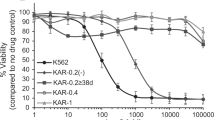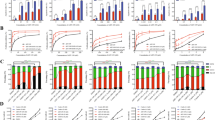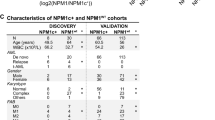Abstract
Sublines of a human myeloid leukaemia cell line, KBM-3, with increasing degrees of resistance to the antileukaemic agent 4'-(9-acridinlylamino) methanesulphon-m-anisidide (m-AMSA) were evaluated for their response to this drug using a clonogenic assay to measure cell survival and alkaline elution to assess m-AMSA induced DNA strand breakage. Polyacrylamide gel electrophoresis was used to map the protein profiles of the various cell lines. The resistant lines were obtained by intermittent exposure of the KBM-3 cells to the highest tolerated concentration of m-AMSA so that the culture would be repopulated only by the most resistant subpopulation after each exposure. Two distinct phases were apparent during the development of resistance. During the first 14 months of intermittent exposure to maximally tolerated concentrations of m-AMSA, the cells developed low-degree m-AMSA resistance (5-7-fold as compared with the parent line, as measured by cell survival). This low-degree resistance was characterised by a somewhat suppressed level of DNA strand breakage and no measurable change in cellular protein levels. Subsequently, a single escalation of the m-AMSA retreatment concentration resulted in a cell population that was approximately 100-fold resistant, as assessed by cloning. This rapid phenotypic change temporally coincided with the acquisition of an almost complete refractoriness to m-AMSA-induced DNA strand breakage and the loss of a cellular 76 kDa protein. We suggest that the loss of this protein is important for the development of a highly m-AMSA resistant phenotype.
This is a preview of subscription content, access via your institution
Access options
Subscribe to this journal
Receive 24 print issues and online access
$259.00 per year
only $10.79 per issue
Buy this article
- Purchase on Springer Link
- Instant access to full article PDF
Prices may be subject to local taxes which are calculated during checkout
Similar content being viewed by others
Author information
Authors and Affiliations
Rights and permissions
About this article
Cite this article
Skinner, W., Murray, D., Kohli, V. et al. Resistance to 4′-(9-acridinylamino) methanesulphon-m-anisidide (m-AMSA) in human myeloid leukaemia. Br J Cancer 61, 51–55 (1990). https://doi.org/10.1038/bjc.1990.11
Issue Date:
DOI: https://doi.org/10.1038/bjc.1990.11



